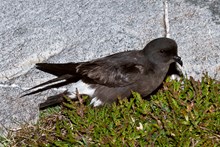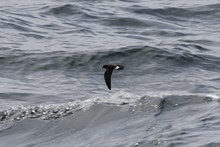22 July, 2021
Storm petrels breeding on Isle of May

Storm petrels have been confirmed breeding on NatureScot’s Isle of May National Nature Reserve (NNR) for the first time.
NatureScot, the UK Centre for Ecology & Hydrology (UKCEH) and the Isle of May Bird Observatory have suspected there may be a colony on the island since 2019, when storm petrels were first spotted displaying and calling.
The species is notoriously difficult to monitor due to its nocturnal habits and the team have been using a variety of techniques to survey areas of the island, including playing a recording of the bird’s calls over potential nest holes in the hope of eliciting a response.
After several efforts a bird was finally heard calling underground during daylight hours when they could only be incubating or brooding a chick.
UKCEH researcher Ella Benninghaus was the lucky individual to confirm with play-back a bird was underground, after smelling the presence of their strong body odour.
She said: “Since storm petrels were first detected on the Isle of May in 2019, it has been an exciting but frustrating three years. We carried out some playback surveys with no success last year, but we were determined to try again this year.
“Sure enough, as I was lying on the ground I heard the storm petrel call back to me very quietly. It is a very exciting find and amazing to be able to prove what has been suspected for a few years.”
Mark Newell, of UKCEH, added: “To confirm the presence of these mystical, magical birds 200 miles from the nearest known colony is one of the highlights of my many years on the isle.”
Storm petrels are small oceanic birds that breed in the UK during the summer months but spend their lives out at sea. The vast majority of the population can be found on remote islands, especially in the north and west of Scotland.
David Steel, Reserve Manager for NatureScot’s Isle of May NNR, said: “These special seabirds come ashore under the cover of darkness and nest underground in crevices, burrows, cairns or stone-walls. They will raise a single chick before eventually departing once again. During that time their nocturnal activities - singing away in total darkness - and unique smell contribute to make these birds so fascinating and mysterious.
“We’re delighted to have confirmation of storm petrel breeding after such a great team effort over the last three years by so many people. The Isle of May National Nature Reserve is hugely significant for its breeding seabird assemblage and this exciting news adds greatly to the importance of this special place.”
Over the years, volunteers at Scotland’s oldest bird observatory on the island have been ringing non-breeding storm petrels and tracking their subsequent movements. Recoveries of ringed birds have shown links to much of the traditional range, mainly to the north and west of Scotland and Ireland.
Alan Lauder, Chair of the Isle of May Bird Observatory Trust, said: “Such a cryptic species, only visiting land at night, means it can be challenging to find storm petrel breeding colonies, especially where they exist in only small numbers.
“Stormies breeding so far south in the North Sea might suggest other nearby colonies may have gone unnoticed, or perhaps that the feeding conditions in the North Sea are more favourable for them now, despite widespread declines in other seabird species.”
ENDS
Contact information
- Name
- NatureScot Media
- Telephone
- 0131 316 2655
- media@nature.scot
Notes to editors
For more information on the Isle of May National Nature Reserve, visit: https://www.nature.scot/enjoying-outdoors/scotlands-national-nature-reserves/isle-may-national-nature-reserve
The UK Centre for Ecology & Hydrology (UKCEH) is a centre for excellence in environmental science across water, land and air. Our 500 scientists work to understand the environment, how it sustains life and the human impact on it – so that together, people and nature can prosper. The UK Centre for Ecology & Hydrology is a strategic delivery partner for the Natural Environment Research Council, part of UK Research and Innovation. www.ceh.ac.uk / Twitter: @UK_CEH
The Isle of May Bird Observatory is Scotland’s oldest bird observatory, founded in 1934, and the longest continuously running observatory in the UK. The observatory is administered by a charitable trust (The Isle of May Bird Observatory and Field Station Trust) and manned by visiting volunteer observers between March and November. The Observatory was founded by a group of young Scottish ornithologists and has continued to depend on the enthusiasm of amateurs who come to the island, usually for a week at a time, to maintain observations and carry out survey and research. It is based in the Low Light, a former navigational lighthouse.
The observatory was established to study bird migration on the Island and is known for its attraction of migrating birds and is well placed to receive “falls” of migrants in spring and autumn. Observatory visitors record the movement of birds through the island including ringing them to learn more about their migration. More information at www.isleofmaybirdobs.org. The Isle of May Bird Observatory and Field Station Trust is a Scottish Charitable Incorporated Organisation, Scottish Charity Number SC001783
NatureScot is Scotland's nature agency. We work to enhance our natural environment in Scotland and inspire everyone to care more about it. Our priority is a nature-rich future for Scotland and an effective response to the climate emergency. For more information, visit our website at www.nature.scot or follow us on X at https://x.com/NatureScot
’S e NatureScot buidheann nàdair na h-Alba. Bidh sinn a’ neartachadh àrainneachd na h-Alba agus a’ brosnachadh dhaoine gu barrachd suim a chur ann an nàdar. Tha e mar phrìomhachas againn gum bi nàdar na h-Alba beairteach agus gun dèilig sinn gu h-èifeachdach le èiginn na gnàth-shìde. Tha an tuilleadh fiosrachaidh aig www.nature.scot no air X aig https://x.com/NatureScot


